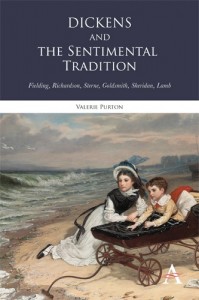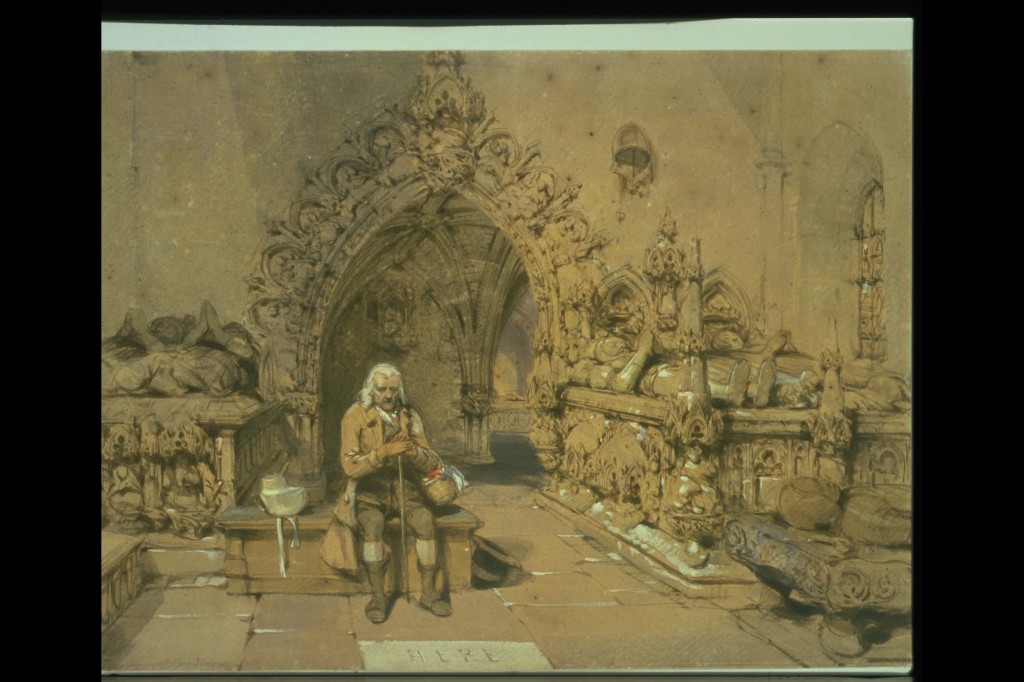Valerie Purton, Dickens and the Sentimental Tradition: Fielding, Richardson, Sterne, Goldsmith, Sheridan and Lamb (London: Anthem Press, 2012)
 After a year of centenary celebrations of Dickens and his world, Valerie Purton’s book reminds us that the author has as many critics as devotees. Purton’s monograph aims to redress some of the criticism aimed at Dickens’ ‘sentimentalism’ and to provide a ‘fuller and fairer’ reading of his fiction, by placing it in the context of what she defines as ‘the sentimental tradition’. Dickens’ eccentric and sometimes grotesque sense of humour is appreciated and mined by writers and broadcasters in our own century, Mark Evans’ Bleak Expectations for Radio 4 being one current example. Dickens’ sentimentalism, however, has not fared as well in British literary or popular culture, thanks to the forces of intellectualism and irony.
After a year of centenary celebrations of Dickens and his world, Valerie Purton’s book reminds us that the author has as many critics as devotees. Purton’s monograph aims to redress some of the criticism aimed at Dickens’ ‘sentimentalism’ and to provide a ‘fuller and fairer’ reading of his fiction, by placing it in the context of what she defines as ‘the sentimental tradition’. Dickens’ eccentric and sometimes grotesque sense of humour is appreciated and mined by writers and broadcasters in our own century, Mark Evans’ Bleak Expectations for Radio 4 being one current example. Dickens’ sentimentalism, however, has not fared as well in British literary or popular culture, thanks to the forces of intellectualism and irony.
The treatment of Dickens’ novels by some as ‘populist’ and ‘anti-intellectual’ provides the starting point for Purton’s study. Her introduction sets out the key questions to be addressed: Why have Dickens’ novels been labelled sentimental and why does this give grounds for dismissing the work? How can we define sentimentalism for Dickens and his Victorian readers? What is the after-life of the sentimentality in Dickens’ works and can this still be appreciated in the twenty-first century?

George Cattermole, The Grave of little Nell, 1867, watercolour. Victoria and Albert Museum, London. © Victoria and Albert Museum, London
Purton’s definition of sentimentalism is firmly grounded a literary history of Dickens’ eighteenth-century and early-nineteenth-century predecessors: Fielding, Richardson, Sterne, Goldsmith, Sheridan and Lamb. Close literary analysis of the specific sentimental characteristics in literature forms the backbone of Purton’s argument. These tropes are not discussed in context of developments in science and philosophy that were shaping society’s understanding of emotions and sentiment. She acknowledges the importance of key works by scholars such as Gillian Beer and George Levine, and does précis key scientific, philosophical and moral texts that tackled the causes and effects of emotion, by authors such as John Keble, Charles Bray, Charles Bell and Charles Darwin, in her introduction, but the ideas contained within these texts and their possible influence on Dickens’ work are not discussed at length. Instead Purton draws upon an impressive array of eighteenth-century texts to explore how Dickens’ own definition of sentimentality was defined and informed by his readings and ‘mis-readings’ of these works.
As she explains in the first chapter, Purton adopts a functionalist approach to her assessments of the characteristics of the sentimental tradition, following the methodologies of Isobel Armstrong’s study of emotion and Victorian poetry. Purton identifies features common to eighteenth-century drama and fiction and Dickens’ novels, such as tearful, but virtuous heroes and heroines; benevolent guardian figures who guide lost ‘children’ and the privileging of pity and self-denial over calculating logic and reason. Central to Purton’s analysis is the idea that Dickens’ inherited understanding of the sentimental tradition was mediated through a Victorian reformulation of ‘sentimentality’, where the heart ruled the head and ‘sentiment’ was cast against the forces of industrialization, mechanization and science. Purton argues that this polarized system, heart vs. head, defines the structures and plots of Dickens’ novels, with ‘feeling’ characters being kept apart from the plotters and schemers that inhabit the darker corners of the Dickensian world.
In the second and third chapters, Purton expands upon her exploration of eighteenth-century literary sentimentalism. She challenges the accepted view, which states that Dickens’ childhood reading of Fielding and Sterne helped form his own moral vision. Instead, the author convincingly argues that while eighteenth-century sentimentalism was closely bound up with anarchic humor and earthly concerns, Dickens’ sentimentalism is an attempt to deny the physical in order to present all human experience in spiritual terms. Purton picks up on this point again in her discussion of Dickens’ understanding of Sheridan’s The School for Scandal. The play shuttles back and forth between wit and sentiment, and never allows the audience to relax into one mode or the other. Dickens’ selective reading of Sheridan, Purton argues, resulted in his discovery of a different source of dramatic power: the extreme separation of humour and sentimentality. The tension involved in keeping these two registers apart results in an intensification of either grotesque humour or deeply felt sentiment in Dickens’ work.

William Egley, Florence Dombey in Captain Cuttle’s Parlour, 1888, oil on canvas. Victoria and Albert Museum, London. © Victoria and Albert Museum, London
Purton’s arguments gain momentum as she goes on to illustrate the occurrences of sentimentality in Dickens’ fiction. Across two chapters, the fifth, which focuses on the earlier novels, in particular The Old Curiosity Shop, and the sixth, which tackles his later work, with the most attention paid to Dombey and Son and Our Mutual Friend, Purton rattles through Dickens’ work at a swift pace. Each selected example is illuminating and allows Purton to develop her ideas about Dickens’ presentation of sentimentality, although many of the intriguing points raised in her analyses could have been explored further. In tantalising passages, Purton introduces the possibility of a Lacanian or Baroque Dickens and I felt the argument could have lingered a little longer on these ideas.
In her conclusion, Purton again draws on ideas from twentieth-century critical theory, in particular the work of Roland Barthes, which is discussed in relation to notions of affect and authorship/readership. Purton argues that the new possibilities opened up the work of by Barthes, Gilles Deleuze and others, has enabled a reassessment of sentimentalism. In turn this has fed into the twenty-first-century scholarly preoccupation with the history of emotions and their literary construction. Although the sentimentalism of Dickens’ work has often been attacked by critics, most prominently J.S. Mill, George Eliot and in the twentieth-century, Virginia Woolf, Purton argues that sentiment and melodrama need to be recognized for their cultural, if not their aesthetic, value. This response will strike a chord with many Victorianists working on literature, art and popular culture that is now considered beyond the pale The clear and elegant prose and logical and perceptive analysis make the book appealing and accessible to scholars and students alike, although there is little concession made to those who are not already familiar with Dickens’ life and work. Possibly revealing more about my own preoccupations than any gaps in Purton’s research, I often found myself wishing that she had mapped some of her ideas around sentimentality onto contemporary ideas about physiology and psychology. Nevertheless, this is an original and convincing book and successfully makes a case for a reassessment of the significance of Poor Little Nell and her sentimental companions.
Katie Faulkner is a visiting lecturer at the Courtauld Institute of Art. She has recently completed a doctoral thesis examining the relationship between Victorian sculpture and dress and is co-teaching a masters’ course looking at art, science and literature in British Aestheticism.

Pingback: Reviewing Dickens, Morris and Collins. | newsculpture